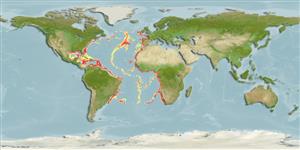Common names from other countries
Environment: milieu / climate zone / depth range / distribution range
Ekologi
laut batidemersal; nir-ruaya; kisaran kedalaman 400 - 2600 m (Ref. 3587), usually 700 - 1400 m (Ref. 3587). Deep-water; 53°N - 34°S, 98°W - 20°E
Atlantic Ocean: Eastern Atlantic: Ireland to South Africa. Western Atlantic: Gulf of Mexico, Caribbean Sea, off Suriname (Ref. 3587). Often confused with Bathygadus favosus Goode & Bean, 1886.
Size / Weight / umur
Maturity: Lm ? range ? - ? cm
Max length : 50.0 cm TL jantan/; (Ref. 6187)
deskripsi pendek
Morfologi | Morfometrik
This species does not have light organs. The head is large; eyes are large, about equal in diameter to the interorbital space. The snout is blunt with the lower jaw slightly projecting. The body tapers quite abruptly from behind the pectoral fin. Body color is light brown. The fin membranes, branchiostegal membrane, gill chamber and body cavity color is black. Also Ref. 2800.
Feeds on mysids, pelagic copepods, chaetognaths and small shrimps (Ref. 3587). Minimum depth reported from Ref. 1371.
Life cycle and mating behavior
Kematangan | Reproduksi, perkembang biakan | Pemijahan | telur-telur | Fecundity | Larva
Cohen, D.M., T. Inada, T. Iwamoto and N. Scialabba, 1990. FAO species catalogue. Vol. 10. Gadiform fishes of the world (Order Gadiformes). An annotated and illustrated catalogue of cods, hakes, grenadiers and other gadiform fishes known to date. FAO Fish. Synop. 125(10). Rome: FAO. 442 p. (Ref. 1371)
Status IUCN Red List (Ref. 130435)
CITES (Ref. 128078)
Not Evaluated
ancaman kepada manusia
Harmless
penggunaan manusia
Perikanan: tidak ada kepentingan
informasi lanjut
AcuanBudidaya airprofil budidaya airStrainGenetikaElectrophoresesDiturunkanPenyakit-penyakitPengolahanMass conversion
mitraGambarStamps, Coins Misc.Suara-suaraCiguateraKecepatanTipe renangArea insangOtolithsOtakPenglihatan / visi
Alat, peralatan
laporan khas
muat turun XML
Sumber internet
Estimates based on models
Preferred temperature (Ref.
115969): 3.5 - 9.8, mean 5.1 (based on 223 cells).
Phylogenetic diversity index (Ref.
82804): PD
50 = 0.5001 [Uniqueness, from 0.5 = low to 2.0 = high].
Bayesian length-weight: a=0.00372 (0.00141 - 0.00980), b=3.11 (2.88 - 3.34), in cm Total Length, based on LWR estimates for this (Sub)family-body shape (Ref.
93245).
Trophic level (Ref.
69278): 3.3 ±0.42 se; based on food items.
Fishing Vulnerability (Ref.
59153): Moderate vulnerability (40 of 100).
